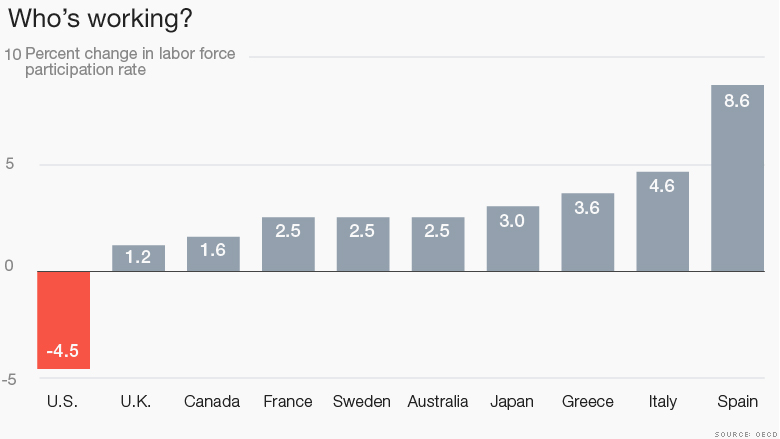
Americans are dropping out of the labor market in droves while residents of Europe and other developed nations, many of which are economically troubled, are jumping in.
Since 2000, America's labor force has shrunk more than any other advanced nation's, even though the U.S. economy has fared better.
The labor force participation rate -- which measures both the employed and those actively looking for work -- has fallen 4.5 percentage points in the U.S. to 72.7% for those age 15 thru 64, according to a recent OECD report that looked at 38 developed countries. And the U.S. is one of only three nations on the list that's contracting.
This trend is emerging despite Europe's economic woes, which have returned to the spotlight amid Greece's troubles. Unemployment and economic malaise is widespread on the continent, with unemployment rates in the double digits in several countries, including France, Spain and Italy.
While the unemployment rate in the United States is on the decline, it's in part for the wrong reasons -- that people are dropping out of the labor market because they've given up on looking for work. Republican presidential candidate Jeb Bush noted last week that the U.S. labor force participation rate is at its lowest in nearly 40 years.
"Many who have stopped actively searching for new jobs may never return to work," the report said.
So why is the U.S. moving in the wrong direction? Part of it is that America's workforce is aging and the Baby Boomers are retiring, said Paul Swaim, principal economist at the OECD.
But the U.S. rate is also declining because women are leaving the workforce to care for their children.
In most of Europe, women's participation in the labor market is on the rise. Not only do mothers have paid leave in Europe, but many fathers do too, Swaim said. Also, childcare is more affordable there.
"Mothers in the U.S. have a harder time combining career and family, especially when the children are young," Swain said.

Also, the U.S. has a sizable number of working-age citizens out on disability with chronic health conditions. Few of them return to the workforce. Europe, on the other hand, is doing more to get the disabled employed again.
The OECD isn't the only organization to find the U.S. falling behind its peers.
The Federal Reserve Bank of St. Louis last month found the U.S. to be the only country among eight developed nations to be slipping backward. It noted that America once had one of the highest participation rates among women age 25 to 54, but now has one of the lowest.
Also, American men in that age group have the lowest rate of participation, hovering just above 88%. The other nations are in the 90% range. Men in the U.S. have also experienced a steep decline in participation since the Great Recession began in 2007.
Looking at younger workers, the U.S. had the greatest decline -- 11.2 percentage points -- between 1995 and 2013. But this is in large part because these youth are in school.
While more Americans nearing retirement are staying in the workforce, the U.S. had the second smallest increase in participation in this age group ahead of Japan.


